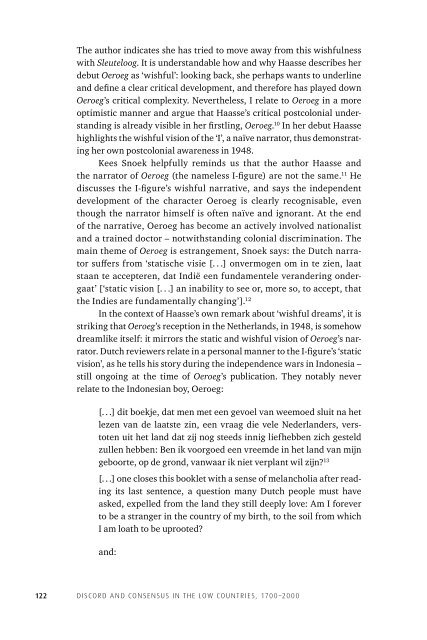Discord Consensus
7aze300jFJo
7aze300jFJo
You also want an ePaper? Increase the reach of your titles
YUMPU automatically turns print PDFs into web optimized ePapers that Google loves.
The author indicates she has tried to move away from this wishfulness<br />
with Sleuteloog. It is understandable how and why Haasse describes her<br />
debut Oeroeg as ‘wishful’: looking back, she perhaps wants to underline<br />
and define a clear critical development, and therefore has played down<br />
Oeroeg’s critical complexity. Nevertheless, I relate to Oeroeg in a more<br />
optimistic manner and argue that Haasse’s critical postcolonial understanding<br />
is already visible in her firstling, Oeroeg. 10 In her debut Haasse<br />
highlights the wishful vision of the ‘I’, a naïve narrator, thus demonstrating<br />
her own postcolonial awareness in 1948.<br />
Kees Snoek helpfully reminds us that the author Haasse and<br />
the narrator of Oeroeg (the nameless I-figure) are not the same. 11 He<br />
discusses the I-figure’s wishful narrative, and says the independent<br />
development of the character Oeroeg is clearly recognisable, even<br />
though the narrator himself is often naïve and ignorant. At the end<br />
of the narrative, Oeroeg has become an actively involved nationalist<br />
and a trained doctor –notwithstanding colonial discrimination. The<br />
main theme of Oeroeg is estrangement, Snoek says: the Dutch narrator<br />
suffers from ‘statische visie [. . .] onvermogen om in te zien, laat<br />
staan te accepteren, dat Indië een fundamentele verandering ondergaat’<br />
[‘static vision [. . .] an inability to see or, more so, to accept, that<br />
the Indies are fundamentally changing’]. 12<br />
In the context of Haasse’s own remark about ‘wishful dreams’, it is<br />
striking that Oeroeg’s reception in the Netherlands, in 1948, is somehow<br />
dreamlike itself: it mirrors the static and wishful vision of Oeroeg’s narrator.<br />
Dutch reviewers relate in a personal manner to the I-figure’s ‘static<br />
vision’, as he tells his story during the independence wars in Indonesia –<br />
still ongoing at the time of Oeroeg’s publication. They notably never<br />
relate to the Indonesian boy, Oeroeg:<br />
[. . .] dit boekje, dat men met een gevoel van weemoed sluit na het<br />
lezen van de laatste zin, een vraag die vele Nederlanders, verstoten<br />
uit het land dat zij nog steeds innig liefhebben zich gesteld<br />
zullen hebben: Ben ik voorgoed een vreemde in het land van mijn<br />
geboorte, op de grond, vanwaar ik niet verplant wil zijn? 13<br />
[. . .] one closes this booklet with a sense of melancholia after reading<br />
its last sentence, a question many Dutch people must have<br />
asked, expelled from the land they still deeply love: Am I forever<br />
to be a stranger in the country of my birth, to the soil from which<br />
I am loath to be uprooted?<br />
and:<br />
122<br />
DISCORD AND CONSENSUS IN THE LOW COUNTRIES, 1700–2000


